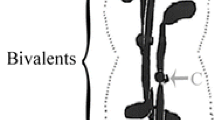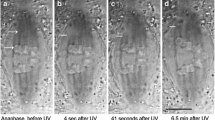Abstract
We have attempted to determine whether chromosomal microtubules arise by kinetochore nucleation or by attachment of pre-existing microtubules. The appearance of new microtubules was investigated in vivo on kinetochores to which microtubules had not previously been attached. The mitotic apparatus of Chinese hamster ovary cells was reconstructed in three dimensions from 0.25 μm thick serial sections, and the location of chromosomes, kinetochore outer disks, centrioles, virus-like particles and microtubules determined. Central to the interpretation of these data is a synchronization scheme in which cells entered Colcemid arrest without forming mitotic microtubules. Cells were synchronized by the excess thymidine method and exposed to 0.3 μg/ml Colcemid for 8 h. Electron microscopic examination showed that this Colcemid concentration eliminated all microtubules. Mitotic cells were collected by shaking off, and cell counts showed that over 95% of the cells were in interphase when treatment began and thus were arrested without the kinetochores having been previously attached to microtubules. Cells were then incubated in fresh medium and fixed for high voltage electron microscopy at intervals during recovery. — In early stages of recovery, short microtubules were observed near and in contact with kinetochores and surrounding centrioles. Microtubules were associated with kinetochores facing away from centrosomes and far from any centrosomal microtubules, and thus were not of centrosomal origin. At a later stage of recovery, long parallel bundles of microtubules, terminating in the kinetochore outer disk, extended from kinetochores both toward and away from centrosomes. Because microtubules had never been attached to kinetochores, the possibility that kinetochore microtubles were initiated by microtubule stubs resistant to Colcemid was eliminated. Therefore we conclude that mammalian kinetochores can initiate microtubules in vivo, thus serving as microtubule organizing centers for the mitotic spindle, and that formation of kinetochore-microtubule bundles is not dependent on centrosomal activity.
Similar content being viewed by others
References
Alov, I.A., Lyubskii, S.L.: Experimental study of the functional morphology of the kinetochore in mitosis. Bull. exp. Biol. Med. 7, 91–94 (1974)
Bajer, A., Molè-Bajer, J.: Formation of spindle fibers, kinetochore orientation and behavior of the nuclear envelope during mitosis in endosperm. Fine structural and in vitro studies. Chromosoma (Berl.) 27, 448–484 (1969)
Berns, M.W., Rattner, J.B., Brenner, S., Meredith, S.: The role of the centriolar region in animal cell mitosis. A laser microbeam study. J. Cell Biol. 72, 351–367 (1977)
DeBrabander, M., DeMey, J., Geuens, G., Joniau, M.: The distribution, function and regulation of microtubules in cultured cells studied with a new “complete” immunocytochemical approach. In: Proc. Elec. Mic. Soc. Amer. (G.W. Bailey, ed.), pp. 10–13. Baton Rouge: Claitor's 1979
Dentler, W.L., Granett, S., Rosenbaum, J.L.: Ultrastructural localization of the high molecular weight proteins (MAPs) associated with in vitro assembled brain microtubules. J. Cell Biol. 65, 237–241 (1975)
Dietz, R.: The dispensability of the centrioles in the spermatocyte divisions of Pales ferruginea (Nematocera). In: Chromosomes today 1, 161–166 (1966)
Forer, A.: Actin filaments and birefringent spindle fibers during chromosome movements. In: Cell motility, Book C (R. Goldman, T. Pollard and J. Rosenbaum, eds.), pp. 1273–1293. Cold Spring Harbor Laboratory 1976
Fuge, H.: The arrangement of microtubules and the attachment of chromosomes to the spindle during anaphase in tipulid spermatocytes. Chromosoma (Berl.) 45, 245–260 (1974)
Fuge, H.: Ultrastructure of mitotic cells. In: Mitosis: Facts and questions (M. Little, N. Paweletz, C. Petzelt, H. Ponstingl, D. Schroeter and H.-P. Zimmermann, eds.), pp. 51–68. Berlin, Heidelberg, New York: Springer 1977
Galavazi, G., Schenk, H., Bootsma, D.: Synchronization of mammalian cells in vitro by inhibition of the DNA synthesis. Exp. Cell Res. 41, 428–451 (1965)
Goode, D.: Kinetics of microtubule formation after cold disaggregation of the mitotic apparatus. J. molec. Biol. 80, 531–538 (1973)
Gould, R.R., Borisy, G.G.: The pericentriolar material in Chinese hamster ovary cells nucleates microtubule formation. J. Cell Biol. 73, 601–615 (1977)
Gould, R.R., Borisy, G.G.: Quantitative initiation of microtubule assembly by chromosomes from Chinese hamster ovary cells. Exp. Cell Res. 113, 369–374 (1978)
Heine, U.I., Kramarsky, B., Wendel, E., Suskind, R.G.: Enhanced proliferation of endogenous virus in Chinese hamster cells associated with microtubules and the mitotic apparatus of the host cell. J. gen. Virol. 44, 45–55 (1979a)
Heine, U.I., Margulies, I, Demsey, A.E., Suskind, R.G.: Quantitative electron microscopy of intracytoplasmic Type A particles at kinetochores of metaphase chromosomes isolated from Chinese hamster and murine cell lines. J. gen. Virol. 45, 631–640 (1979b)
Inoué, S.: Organization and function of the mitotic spindle. In: Primitive motile systems in cell biology (R.D. Allen and N. Kamiya, eds.), pp. 549–594. New York: Academic Press 1964
Inoué, S., Ritter, H., Jr.: Mitosis in Barbulanympha. II. Dynamics of a two-stage anaphase, nuclear morphogenesis and cytokinesis. J. Cell Biol. 77, 655–684 (1978)
Jensen, C., Bajer, A.: Spindle dynamics and arrangement of microtubules. Chromosoma (Berl.) 44, 73–89 (1973)
Kim, H., Binder, L.I., Rosenbaum, J.L.: The periodic association of MAP2 with brain microtubles in vitro. J. Cell Biol. 80, 266–276 (1979)
LaFountain, J.R., Jr.: Analysis of birefringence and ultrastructure of spindles in primary spermatocytes of Nephrotoma suturalis during anaphase. J. Ultrastruct. Res. 54, 333–346 (1976)
LaFountain, J.R., Jr., Davidson, L.A.: An analysis of spindle ultrastructure during prometaphase and metaphase of micronuclear division in Tetrahymena. Chromosoma (Berl.) 75, 293–308 (1979)
Lambert, A.M., Bajer, A.S.: Dynamics of spindle fibers and microtubules during anaphase and phragmoplast formation. Chromosoma (Berl.) 39, 101–144 (1972)
Luykx, P.: Cellular mechanisms of chromosome distribution. Int. Rev. Cytol., Suppl. 2, 1–173 (1970)
McGill, M., Brinkley, B.R.: Human chromosomes and centrioles as nucleating sites for the in vitro assembly of microtubles from bovine brain tubulin. J. Cell Biol. 67, 189–199 (1975)
McIntosh, J.R., Cande, W.Z., Snyder, J.A.: Structure and physiology of the mammalian mitotic spindle. In: Molecules and cell movement (S. Inoué and R.E. Stephens, eds.), pp. 31–76. New York: Raven 1975a
McIntosh, J.R., Cande, W.Z., Snyder, J.A., Vanderslice, J.: Studies on the mechanism of mitosis. In: The Biology of cytoplasmic microtubules (D. Soifer, ed.), pp. 407–427. New York: N.Y. Acad. of Sciences 1975b
Molé-Bajer, J., Bajer, A., Owczarzak, A.: Chromosome movements in prometaphase and aster transport in the newt. Cytobios 13, 45–65 (1975)
Mollenhauer, H.H.: Plastic embedding mixtures for use in electron microscopy. Stain Technol. 39, 111–114 (1964)
Murphy, D.B., Borisy, G.G.: Association of high-molecular-weight proteins with microtubules and their role in microtubule assembly in vitro. Proc. nat. Acad. Sci. (Wash.) 72, 2696–2700 (1975)
Murphy, D.B., Johnson, K.A., Borisy, G.G.: Role of tubulin-associated proteins in microtubule nucleation and elongation. J. molec. Biol. 117, 33–52 (1977)
Nicklas, R.B.: Mitosis. Adv. Cell Biol. 2, 225–297 (1971)
Nicklas, R.B., Brinkley, B.R., Pepper, D.A., Kubai, D.F., Rickards, G.K.: Electron microscopy of spermatocytes previously studied in life: Methods and some observations on micromanipulated chromosomes. J. Cell Sci. 35, 87–104 (1979)
Östergren, G.: The mechanism of co-orientation in bivalents and multivalents. Hereditas (Lund) 37, 85–156 (1951)
Paweletz, N.: Electronenmikroscopische Untersuchungen an frühen Stadien der Mitose bei HeLaZellen. Cytobiol 9, 368–390 (1974)
Pease, D.C.: Hydrostatic pressure effects upon the spindle figure and chromsome movement. II. Experiments on the meiotic divisions of Tradescantia pollen mother cells. Biol. Bull 91, 145–169 (1946)
Pickett-Heaps, J.D., Tippit, D.H.: The diatom spindle in perspective. Cell 14, 455–467 (1978)
Roos, U.P.: Light and electron microscopy of rat kangaroo cells in mitosis III. Patterns of chromosome behavior during prometaphase. Chromosoma (Berl.) 54, 363–385 (1976)
Roth, L.E.: Electron microscopy of mitosis in amebae. III. Cold and urea treatments: A basis for tests of direct effects of mitotic inhibitors on microtubule formation. J. Cell Biol. 34, 47–59 (1967)
Sherline, P., Schiavone, K.: High molecular weight MAPs are part of the mitotic spindle. J. Cell Biol. 77, R9-R12 (1978)
Snyder, J.A., Mclntosh, J.R.: Initiation and growth of microtubules from mitotic centers in lysed mammalian cells. J. Cell Biol. 67, 744–760 (1975)
Telzer, B.R., Moses, M.J., Rosenbaum, J.L.: Assembly of microtubules onto kinetochores of isolated mitotic chromosomes of HeLa cells. Proc. nat. Acad. Sci. (Wash.) 72, 4023–4027 (1975)
Telzer, B.R., Rosenbaum, J.L.: Assembly of microtubules onto kinetochores, centrioles and pericentriolar material of mitotic HeLa cells. J. Cell Biol. 75, 281 a (1977)
Wheatley, D.N.: Pericentriolar virus-like particles in Chinese hamster ovary cells. J. gen. Virol. 24, 395–399 (1974)
Author information
Authors and Affiliations
Rights and permissions
About this article
Cite this article
Witt, P.L., Ris, H. & Borisy, G.G. Origin of kinetochore microtubules in Chinese hamster ovary cells. Chromosoma 81, 483–505 (1980). https://doi.org/10.1007/BF00368158
Received:
Accepted:
Issue Date:
DOI: https://doi.org/10.1007/BF00368158




